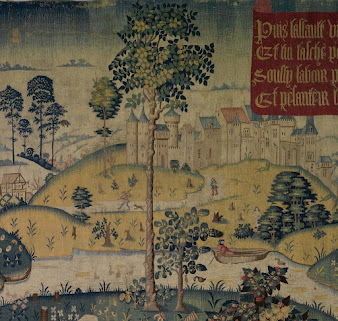An amazing collection, much of it kept in an amazing museum, The Cloisters. Above, reliquary cross from Italy, 14th century.
Tomb of County Ermengol VII of Urgell, in Catalonia, 1314. If you're wondering how all this stuff ended up in New York, including big pieces of buildings, I would say by means both fair and foul. Some of it was willingly sold off by European countries in the decades around 1900, because 1) they simply could not afford to maintain their enormous medieval heritages, and 2) they had to destroy a lot of old buildings to develop modern economies and house their exploding populations. So some of these sales were completely above-board. On the other hand, corrupt networks certainly just stole a lot of stuff or bribed officials to look the other way as it was smuggled out; this was especially bad in the south of Italy. So you can't look at any of these pieces and know how dubious its origin, and frankly the Met web site doesn't make it easy to check.
Background to a hunting tapestry, Flemish, c. 1475
A clasp from the low countries, 13th century.
Sculpted corbel from a French monastery, c. 1150
Ivory crozier from northern Italy, c. 1375
Drinking cup. British, 12th century
Door, Spanish or Catalan, 12th century
Tournament shield, Germany, c. 1450
Carved double capital, France, c. 1200
Joshua, from a tapestry depicting the Nine Heroes, c. 1410
The Priest Aaron, France, c. 1170
Ivory plaque depicting the Last Supper, c. 1400
Chalice from France, c. 1450
And I suppose there's no point in posting this without by far the most famous work in The Cloisters, The Unicorn in Captivity tapestry, c. 1500.


















No comments:
Post a Comment